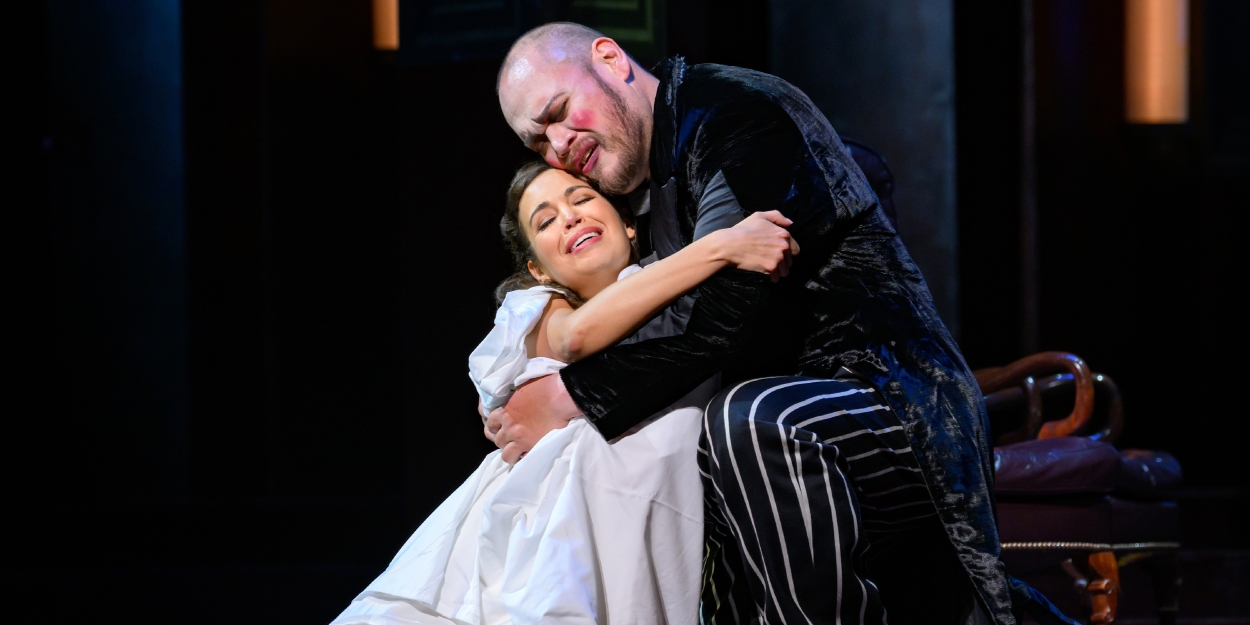Review: With Great Music But Little Jesting, RIGOLETTO Returns to the Met
Sierra and Kelsey Cement the Center of Sher’s Verdi under Morandi

“This is not a cathartic tragedy or a tale of noble sacrifice. There are no admirable characters here, no moral lesson, no redemption, and no silver lining. There is only a merciless depiction of society’s dark side,” say the Met’s program notes for RIGOLETTO.
I’m not so sure. There is certainly great poignancy in the intimate scenes between the title character (the mostly booming baritone of Quinn Kelsey), the court jester, and his naïve yet somehow too worldly daughter Gilda (the breathtaking soprano Nadine Sierra). Even if the characters sometimes are hard-put to get our sympathy, their relationship transcends the darkness of the story and brings out the best in the opera.
Although there was much to admire in his performance, seen on October 4, I found Kelsey’s demeanor too scary when dealing with the courtiers or the hitman Sparafucile (the excellent bass Soloman Howard), but it’s one of his trademarks. (He’s the only truly terrifying Pere Germont I’ve heard in TRAVIATA.) When he lashes out at the members of the court in “I cortigiani,” I was amazed they didn’t run in terror.
But put him in close contact with his daughter and it seems to melt his heart and we feel the love between them. He is protective and we see it, even if she is a headstrong girl who he knows will not always follow his advice. Sierra’s Gilda sometimes seems a little more mature than we expect from this girlish figure, but not when she’s together with Kelsey. They somehow pull a performance from somewhere deep within themselves that neither shows elsewhere in the opera. They are the center of the opera and bring all their past experience to making us embrace them as they embrace each other.
In a production that often appears to have been without mooring, that’s no small achievement, but Kelsey and Sierra are fine artists when they are at their best. Still, the rest of the evening was disappointing. As the Duke, tenor Stephen Costello took long to warm up—I found it hard to hear him at the start of the first act—and his boyishness played against the role elsewhere.
The performance was at its worst during Act III, at the lair of the assassin Sparafucile, which emphasized all that didn’t work here. This final act features two of Verdi’s greatest “hits”: “La donna e mobile,” which they were singing in the streets of Venice after the opening performance of the opera in 1851, and the quartet, “Bella figlia dell’amore,” for Rigoletto, Gilda, the Duke and Sparafucile’s sister, Maddalena.
In all the times, in all the productions I’ve seen of the opera, never before have these pieces failed to “land,” and make us happy to be there, despite the grimness of the action. Here, it all sounded muddy, as if everyone was trying to drown out the others. Without the music to enfold us, the thrill of Verdi’s great score was frequently lost, making us question whether this masterpiece has been overpraised (which is, of course, ridiculous).
I credit Bartlett Sher’s direction (recreated here by Sara Erde) for this, going back to the production’s opening on New Year’s Eve 2021--and for giving us the so-called Weimar theme, without really carrying it through in its look (the design of Michael Yeargan with lighting by Donald Holder and costumes of Catherine Zuber) or feeling. They gave us a curtain that, indeed, evoked the period, then seemed to have forgotten that they laid the groundwork for it.
Among the others caught up in the performance were baritone Jordan Shanahan as a notable Monterone, whose curse sets the course of the story in motion, and mezzo Eve Gigliotti, as Gilda’s companion, Giovanna. Mezzo J’Nai Bridges was Maddalena.
Maestro Pier Giorgio Morandi propelled the Met orchestra well through its paces and Chorus Master Tilman Michael kept the courtiers blazing along.
Back to the program notes again, editor Jay Goodwin refers to RIGOLETTO as “Opera noir.” In this performance, I often found it more than a little like “Opera blah.”
With this cast, RIGOLETTO will be on view at the Met through November 8. The opera returns in January with an alternate group of singers, including baritone Luca Salsa as Rigoletto, soprano Erin Morley as Gilda and tenor Pene Pati as the Duke. For more information and tickets, see the Met’s website.
Reader Reviews
Videos

